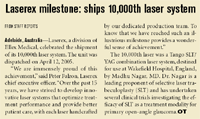Article
DLEK data, outcomes favorable in largest clinical series to date
Accumulating data indicate that deep lamellar endothelial keratoplasty (DLEK) is an excellent alternative to penetrating keratoplasty (PKP) as a corneal transplant procedure in eyes with endothelial dysfunction, according to Mark A. Terry, MD.

Dr. Terry presented 6-month results with 100% follow-up from his personal initial series of 90 eyes. In the first 36 eyes, DLEK was performed introducing the endothelial donor tissue through a 9-mm incision, whereas folded tissue was inserted through a 5-mm incision in the subsequent 54 procedures.
Relative to historical data for PKP, DLEK offered comparable best-corrected visual acuity (BCVA) results, but appeared to have advantages for minimizing astigmatism, maintaining endothelial cell counts, and avoiding a number of early complications.

"Furthermore, DLEK transplants healthy endothelium and seems to be associated with endothelial cell counts that are as good as, or better than, those seen after PKP," he said.
"DLEK surgery continues to improve through the prospective efforts of the international Endothelial Keratoplasty Group and more than 360 procedures have been performed to date," Dr. Terry continued. "Meanwhile, given the outcomes achieved so far and considering its potential long-term advantages, we believe DLEK surgery should be considered first when corneal transplantation is needed in eyes with endothelial disease."
The 90 eyes in the series included 88 eyes with Fuchs' dystrophy and two eyes with pseudophakic bullous keratopathy. Forty-nine eyes were pseudophakic at the time of DLEK and the corneal transplant procedure was combined with phacoemulsification in 36 eyes.
All patients were able to wear normal spectacles at 6 months after DLEK. At that visit, BCVA in the small-incision subgroup (n = 54) averaged 20/46 (range, 20/20 to 20/400) and was 20/40 or better in nearly two-thirds of eyes. The eyes with poor vision had clear corneas but retinal macular disease.
Mean SE was close to plano, and mean astigmatism was 1.35 D with a maximum of 4 D. The average change in astigmatism from preoperative levels was <0.50 D.
"DLEK causes essentially no significant change from preoperative astigmatism or topography, and you will not find postoperative astigmatism outcomes as good as this in any PKP study in history," Dr. Terry said. "DLEK also allows more accurate selection of IOL power for eyes undergoing a combined procedure and thereby results in nearly emmetropic outcomes for those cases."
Mean endothelial cell count at 6 months was 2,144 cells/mm2 and reflected a 24% loss from baseline. This is comparable with the cell loss seen after traditional PKP, Dr. Terry noted. He reported his results during the annual meeting of the American Academy of Ophthalmology in New Orleans last fall.
"Endothelial cell counts provide the proof of the pudding, because if there is not healthy endothelium after the procedure, then the surgery has not delivered on its primary goal," Dr. Terry said. "These results indicate DLEK transplants healthy and abundant donor endothelium, and we believe it is superior to PKP in that regard."
Newsletter
Don’t miss out—get Ophthalmology Times updates on the latest clinical advancements and expert interviews, straight to your inbox.




